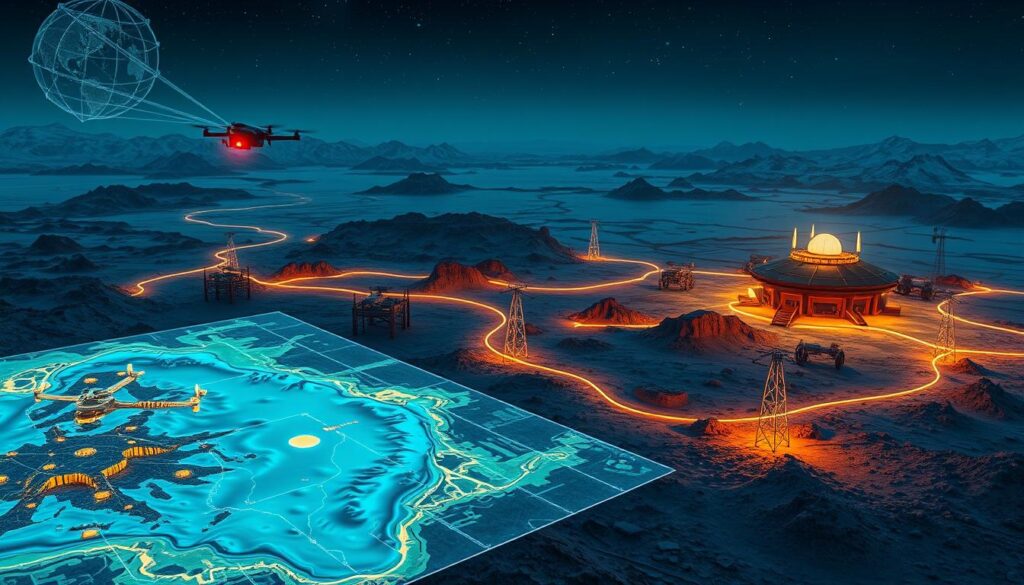The future of geophysics is changing fast. It’s all about how quickly we can gather, process, and understand data. This is key for making smart decisions in energy exploration.
Recently, over 7,000 geoscientists met at the Society of Exploration Geophysicists’ (SEG) International Exposition in San Antonio. They saw the latest tech in geophysics. This included artificial intelligence and data analytics1.
The event had 90 sessions and 20 workshops on geophysics and tech1. There were also talks on new ways to collect seismic data.
Digital Transformation Geophysics

The U.S. Geological Survey talked about using geophysics for renewable energy like geothermal and solar1. Aramco shared over 20 papers at the SEG event, showing off their tech progress1.
Aramco also supported the SEG’s Evolve program for new graduates1. They even had a Geology Camp for science teachers at Texas A&M University1. Houston-based Aramco staff were there to recruit1.
Key Takeaways
- The geophysics industry is changing fast, thanks to tech like AI and IoT sensors.
- Geophysicists use digital tools to analyze data better, find patterns, and predict more accurately.
- Digital tech and old geophysics methods together help make better decisions and find more resources.
- But, there are challenges like keeping data safe and getting people to use new tools. Training and showing the benefits are key.
- The future of geophysics will need more people who can work with digital tools and complex data.
The Advent of Digital Transformation in Geophysics
The field of geophysics is changing fast, thanks to digital transformation. Digital transformation geophysics brings new tech into every part of the field. This makes collecting, analyzing, and using geophysical data much better.
New geophysics technologies are changing how we explore the subsurface and use geophysical methods. These tools help automate data work and improve analysis accuracy2.
Dealing with big data is easier now, thanks to digital tools. Cloud computing, data analytics, and AI speed up data processing and interpretation3.
As digital transformation grows, geophysicists will benefit a lot. They’ll have access to the latest digital tools. This will help them understand the Earth’s subsurface better and lead to new discoveries4.

“The integration of digital technologies is empowering geophysicists to unlock new possibilities in data analysis and interpretation, driving advancements in our understanding of the Earth’s subsurface.”
The Role of digital transformation geophysics
The digital transformation in geophysics is changing how we collect, process, and understand data. New technologies like AI in geophysics, IoT in geophysics, and big data analytics geophysics are key. They make our work more accurate, efficient, and collaborative5.
New ways to process and interpret data are leading this change. Machine learning algorithms make analysis faster and more accurate. Cloud computing helps teams work together smoothly from anywhere in the world56.
The effects of digital transformation in geophysics are huge. Remote sensing and drone surveys let us get lots of data fast5. Virtual reality (VR) lets us see underground structures in a new way, making complex ideas easier to grasp5.
Automation cuts down on mistakes and boosts productivity. Real-time data collection helps us make quick decisions in changing situations5.
But, there are hurdles to overcome. Starting to use new tech costs a lot, and we need experts to use it right5.
As we move forward, geophysicists must find a balance. We need to keep using old ways while also trying new ones. This keeps us up to date with the fast-changing world5.

“Cutting-edge technology allows for improved efficiency, enhanced data accuracy, and better decision-making capabilities, shaping the landscape of exploration and analysis within geophysics.”
Tackling Big Data Challenges in Exploration
The geophysics industry is facing a big challenge in managing lots of data from exploration7. Geophysicists need new ways to find important insights in this geophysical big data8.
Using geophysical data management and geophysical data analytics is key. Machine learning and artificial intelligence help find patterns in complex data7.
For example, Petrobras used machine learning to classify 3D stratigraphic facies in Brazil7. In the DJ Basin, machine learning helped create a detailed seismic classification volume7.
Integrating geophysical data integration tools is also important. By mixing data from seismic surveys, gravity, and satellite images, geophysicists get a better view of the subsurface8.
“Most challenging now is how we make sense of the huge amounts of data we collect, how we write meaningful algorithms to simulate the complex factors in predicting reservoir properties,” said Saleh A. Al Maghlouth, manager of the Geophysical Imaging Department in Exploration with Saudi Aramco.
As the industry moves towards digital transformation, managing and analyzing geophysical big data is key78. It will help drive exploration success and open new doors in geophysics78.
Integrating Digital Tools with Traditional Methods
The digital world has changed geophysics a lot. Now, geophysicists use advanced software to analyze data better. Geophysical data integration and geophysical data visualization tools help them understand results quickly9. Cloud computing also helps by storing big data and making it easier to access.
But, mixing old ways with new digital tools is hard. Some geophysicists don’t want to change. They need training and to see how these geophysical software tools help9.
“The integration of innovative technologies such as fiber optics, drones (UAVs), and machine learning into geophysical research is highlighted for creating more robust monitoring solutions for sustainable energy applications.”10
Going digital in geophysics has its hurdles, but the benefits are big. With digital transformation geophysics, geophysicists can work more efficiently and accurately. This helps the industry grow and face new challenges.
Geophysical methods, like seismic imaging, are key for tracking CO2 plumes. They help keep CO2 in place and reduce risks in CCUS projects10. Also, combining seismic and microgravity data helps with sinkhole prevention, which is vital for fighting climate change10.
As the field changes, geophysicists must be open to new digital tools and methods. By embracing digital transformation geophysics, they can open up new possibilities. This helps us move towards a more sustainable future.
Industry Adoption and Case Studies
The digital transformation is changing many industries, including geophysics. Companies are using new technologies to improve their work. They are using AI for seismic data and IoT for monitoring geological activities11.
In the oil and gas sector, AI helps predict when equipment might fail. This means less downtime and better work efficiency12. Digital twin technology also helps by simulating assets. This lets companies make better decisions and work smarter12.
Edge computing is another big change. It makes data processing faster, which is key in tough geological areas. This helps in making quick decisions in the field12.
Despite progress, the geophysics industry still faces challenges. Issues like data quality and a lack of skilled workers are big hurdles12. But, partnerships between energy companies and tech leaders are finding new solutions12.
The future looks bright for geophysics. New tech like natural language processing and autonomous systems will bring more benefits. With a focus on innovation, the geophysics sector is set to see even more improvements1213.
The Future Outlook for Digital Transformation Geophysics
The future of digital transformation in geophysics is full of promise. New technologies like artificial intelligence (AI) and machine learning will change how we analyze data. By 2024, AI and machine learning will make data analysis better, more predictive, and faster14.
Big data analytics will also be a big help in geophysics. They will improve planning, risk assessment, and predicting geological events. This will make exploration more efficient14.
Cloud computing is another big plus for geophysics. It makes it easier to grow and change infrastructure, saves money, and helps teams work together better14.
Digital twins are also changing the game. They create virtual models for monitoring and simulating geologic conditions. This improves safety, cuts costs, and boosts design and productivity14.
The Internet of Things (IoT) devices are being used more in geophysics. They collect data in real-time, making remote sensing and data transmission smoother. This also helps with machine maintenance in tough places14.
The job market for geophysicists will change with these new technologies. Those who can use digital tools and analyze complex data will be in demand. To stay ahead, geophysicists need to keep up with the latest tech15.
In summary, digital transformation in geophysics will make the field more efficient and effective. Geophysicists who adapt to these changes will do well in the evolving job market141615.
Transforming Legacy Data for Digital Transformation
The journey to digital transformation in geophysics often starts with legacy data. Huge amounts of seismic, well logs, maps, and more are stuck on paper or old media. This makes it hard to access and analyze them17. Moving these to a digital format is key for companies to use their data fully18.
Digitizing geophysical data is the first step to unlocking its value. By turning paper and old media into digital, companies can use this data in new ways. This makes data management better and makes it easier to move and analyze data18.
The benefits of going digital are huge19. Oil and gas companies can save up to $1 billion a year by digitizing their data. They can also increase oil production by up to 8%19. Plus, they can save up to $8 billion a year by cutting down on data management work19.
Working with experts in geophysical data management can really help19. These experts have the skills and tools to make the digital transformation happen. This lets companies get the most out of their old data19.
“The digital transformation of legacy geophysical data is a critical step in unlocking the full potential of our industry’s vast data resources.”
As the geophysics industry goes digital, moving old data to new formats is key. By digitizing geophysical data, companies can unlock their historical data. This drives innovation, efficiency, and keeps them ahead in the future.
Conclusion
Digital transformation has changed geophysics, bringing new ways to collect, analyze, and understand data20. New technologies like AI, machine learning, and cloud computing have made geophysics more accurate and efficient20. This change has made it easier for more people to work in the field20.
The benefits of digital transformation in geophysics are many20. It has improved how we manage and analyze data, making it safer and more reliable for making decisions20. New methods in marine geophysics and non-invasive techniques have changed how we study Earth’s processes20. These advancements help plan and execute projects better20.
Remote sensing, drones, and virtual reality have also changed geophysics21. They let geophysicists see and monitor geological features with great detail21.
The future of digital transformation in geophysics looks very bright21. New technologies like AI, big data analytics, and IoT will keep improving geophysics21. They will help solve big problems like climate change and resource scarcity21.
As geophysics keeps embracing digital transformation, the field will keep growing and discovering new things22. This will lead to a more sustainable and prosperous future22.
Source Links
- Geophysicists look to artificial intelligence in digital transformation era
- Fourth EAGE Digitalization Conference & Exhibition
- Digital Transformation Consulting
- Destination Earth
- Digital Transformation Geophysics: A New Frontier in Geophysics
- Digital Transformation in Geophysics: Embracing Change – Tech Miny
- Geophysical Insights – What is Big Data?
- Exploring the Depths: Geophysics Data Science Project Management Unveiled
- AI in Geophysical Surveys: Enhancing Data Acquisition, Processing, and Reporting
- Episode 235: Advancing Sustainability through Applied Geophysics – SEG
- Digital transformation in energy: Achieving escape velocity
- How AI is Transforming Businesses in the Oil and Gas Industry
- Don’t Forget People in Your Digital-Transformation Programs: Change Management Is an Essential Competency
- Top Digital Transformation Trends in Geophysics for 2024 | Insights
- Global Geophysical Services and Equipment Market Future Outlook and Projections
- Digital transformation
- The New Elements of Digital Transformation
- Data Management Articles | Seismic Cloud Solutions | Katalyst
- Digital Transformation to Boost Oil and Gas Production – GeoExpro
- How Digital Transformation is Revolutionizing Geophysics – Dalvico
- Digital Transformation Geophysics: Study of Earth
- Advancements in Seismic Imaging and Earth Model Building Using Digital Transformation


1 thought on “Digital Transformation in Geophysics: A New Era”
Comments are closed.